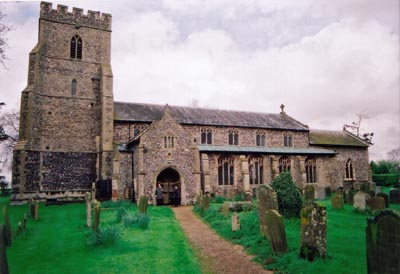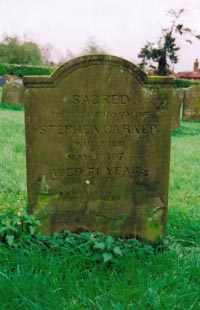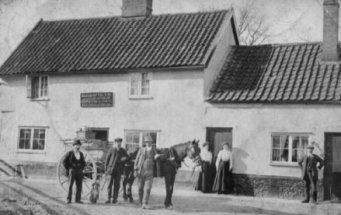Blacksmiths and Engineers.

The church at Ashill, Norfolk. Two Garner descendants stand in front of the porch. Most of the Garner graves are close to the church on the right of the path that leads from the porch.
Early Garners - Blacksmiths
The Garners are from Norfolk where the name appears frequently. The family appear to have been craftsmen, generally blacksmiths. They were living in the village of Ashill by 1769 when John Garner and Elizabeth his wife, had a son, John, the first of four children.
John was a blacksmith and appears to have had the fiery temper traditionaly ascribed to that trade. He was bankrupted in 1776 but probably recovered as he was still trading as a blacksmith in Ashill in 1790 when he was forced to issue a public apology:
Wheras I, John Garner, of the Parish of Ashill, in the County of Norfolk, Blacksmith, did sometime since (without any provocation) scandalize and abuse the Character of Mr. James Harpley, of Norton, near Fakenham, by saying he had not paid his Rent, and other abusive Expressions; for which Defamation the said Mr. Harpley have threatened me with a Prosecution. But upon my asking him Pardon in this public Paper, paying for this Advertisement, and promising him never to be guilty of the like, or any other offence, he has been so good as to forgive me. [Norfolk Chronicle, 8th May, 1790]

John's son (also John) seems to have had a more placid character (unless the writer of his tombstone epitaph was being ironic). I assume that John was also a blacksmith - though I have no evidence of this.
John married Mary Betts, obviously a woman of some means as she left a will and had it proved in the court at Canterbury (rather than the local diocesan court). She gave her maiden name as a middle name to many of her descendents. John and Mary had at least eight children - including a daughter, Mahalah (born 1800 - the name then having a brief spell in fashion). Their fourth son, John, became a wheelwright and moved to Burnham Thorp - Nelson's birthplace - where he became landlord of the local inn (The Lord Nelson - what else?). Their third child and eldest son, Stephen (my ancestor), remained in Ashill where he worked as a blacksmith.
John and Mary Garner were buried by the South door of Ashill church. John's tombstone reads:
In memory of John Garner who died March 3 1818 aged 49 years. An honest man lies here interr'd For truth and Justice he preferr'd He shew'd thro' life a generous mind And died in peace with all mankind.
Mary lived on for nearly twenty years. Her tombstone reads:
In memory of MARY wife of JOHN GARNER who died November 17th [?] 1837 aged 66 years. Blessed are the dead which die in the Lord
John and Mary's oldest son, Stephen, lived in Ashill from his birth in 1802 until his death in 1873. He married Mary Platfoot from the neighbouring village of Carbroke. Mary's brothers obviously felt sensitive about their surname and changed it to Platford. Stephen and Mary had ten children. Their oldest son, John, became the Ashill wheelwright. All the other boys became blacksmiths. The girls mostly died unmarried in their late teens and early twenties.
On 22nd of July, 1866 the Norfolk News carried the story:
Philip Johnson and John Purse, both of Ashill, were charged by Stephen Garner, of the same place, blacksmith, with being drunk on Sunday, the 1st inst., and while in that state entering the Primitive Methodist chapel and behaving in a most disorderly manner. He was commited to Swaffham Bridewell for 14 days.
There is obviously an error in this report. Who was the drunkard?

Mary died in 1853. She was buried at Ashill, next to her in-laws and several of her children. Her tombstone reads
In memory of Mary, wife of STEPHEN GARNER who died Jan 14th 1853 aged 43 years. Also three of their children. Now her spirit is above With her Jesus that she loved She bless the day When Jesus wash'd her sins away
Stephen lived another twenty years. His tombstone reads:
Sacred to the memory of Stephen Garner who died May 3 1873 aged 71 years.
Therefore being justified by faith We have peace with God Through our Lord Jesus Christ
Stephen Garner jun.
Their second son Stephen was born in about 1837. In the census of 1851 he was described as 'Apprentice Blacksmith' - presumably apprenticed to his father with whom he was living.
At around the time the census was taken, Stephen had what must have been a most unsettling experience. This report is from the Norfolk Chronicle of 5th April, 1851:
Burglary at Ashill.
William Morgan (25), Frederic Perkins (20), and
Joseph Welsh (23). were charged with having broken and entered the dwelling-house of Robert Cadge, a publican, of Ashill, and stolen therefrom a pair of shoes, a cotton handkerchief, and a pair of stockings, his property. Mr. Evans and Mr. Couch prosecuted. The prisoners were undefended. On the morning of February 12th, some thieves broke open and entered the prosecutor's house, violently assaulted him and his wife while they were in bed, and stole the articles mentioned in the indictment. The question was, whether the prisoners were the thieves. On the night before the burglary, it being a bright night, about nine o'clock, a lad named Stephen Garner saw Morgan and Perkins near the White Hart public-house. Early on the following morning the lad saw a girl run past his house shrieking, and heard her say something. The lad went to the public-house, ran upstairs, and found Mr Cadge with his head broken and blood all over him.
Sarah Wright saw three men like the prisoners in Swaffham, on the night before the robbery. Morgan the tallest man, with only one arm, asked her the way to Brandon. The prisoners were the same men. Ashill was about six miles distant from the place where they left her. She knew the men by their appearance and dress. John James, who lives at South Pickenham. near Ashill, remembered on the evening of Feb. 11th, three men like the prisoners passing him. After that he saw them again, and one of them asked the way to Ashill. He believed the prisoners were the same men. Mary Amiss, who lives at Ashill, on the night of the burglary saw three men like the prisoners at half-past eight o'clock. She was not sure whether two of the men were the same. She was certain that Morgan was one of the men. Mary Hardy, who lives at Foulden, remembered on the morning of Feb. 12th, the prisoner Welsh came and offered to sell her a pair of shoes. Those produced were the same. She saw the prisoner again on the same day, and two men with him.
The prosecutor stated that on the night of the burglary he had left his shoes at the bottom of the stairs before he went to bed, and he missed them on the following morning. Robert Alcock. a shoemaker, deposed that he had made the shoes produced for the prosecutor. There was no particular mark on the shoes. but he knew them to be the same. The next witness was James Foster, who, on February 12th, was at Northwold, about 11 o'clock, and saw Morgan near the church, and he offered to sell a pair of shoes. Then two other men came up, and witness asked to look at the shoes. Perkins was one of the men. and he pulled the shoes out of his pocket, and witness bought them for 2s. 6d. Another man had blood on his coat. He believed that the coat produced was the same. The shoes were the same. Witness bought the handkerchief from Morgan, and both the shoes and handkerchief were given to the policeman Dowde.
Payne Bennet, of Fouldon, situated between Ashill and Northwold, said, on Wednesday, Feb. 12. he went to the Crown public-house, at Northwold, and saw the three prisoners there. Morgan had a hat on; Perkins had nothing on his head; Welsh asked if any one in the place sold caps, and he went out and bought a cap and came back with it. William Mayle, who keeps a shop at Northwold, said, on February 12th, a stranger like Welch came into his shop and bought a cap. John Byles, a policeman, produced two caps that he received from Mrs. Cadge. He said, the distance between Foulden and Ashill was 7 or 8 miles. Another policeman had received the shoes produced; and brought Welsh, Morgan, and Perkins from Cambridge, where they were in custody. When told of the charge against them they said they had never been at Ashill. John Rivett, another policeman, had found a frock coat in the house where Morgan and Perkins lived, and he produced it. There
were marks of blood on the coat. This policeman took a new cap from Perkins's head. Wm. Mayle identified this cap as one he had sold to the prisoner.
All three prisoners, in defence, urged that there was not sufficient evidence as to their being the same men said to be seen at Ashill and other places.
The learned Judge recapitulated the evidence, and the jury returned a verdict of "Guilty" against all three prisoners. Morgan and Perkins had been previously convicted. The learned Judge having remarked on the heinousness of the offence, ordered sentence of death to be recorded.
The Register of the Norfolk Assizes records the sentence of death but shows that it was commuted to transportation for life. One can only imagine what effect it must have had on Stephen, seeing three men sentenced to death, partly on his evidence.
By the time of the census in 1861, Stephen had married and moved to Shingham where he was described as 'Blacksmith and Engine Driver'. Stephen had become involved with the exciting new technology of steam engines which were revolutionising agriculture. These great steam engines were the workhouses of the arable farms of East Anglia, driving the newly invented machinery that was rapidly replacing human and animal.

By 1871 the family had moved back in Ashill. Stephen had taken over the smithy from his father, who is now described as 'Retired Blacksmith'. His family had grown and now included six children. Stephen's younger brother, Henry, was also a blacksmith. The census shows that the Garner's smithy was in Church Street, next door to the White Hart Inn.
Stephen married Susan Barkham from Beachamwell. Her mother's Eastgate family had been farmers in Feltwell since the early 1600s. They had nine children. All except Kate the youngest were born in Ashill. Kate was born in Sittingbourne, Kent, in 1878. By 1881, the family were living in Margate, in 'Noah's Ark', a makeshift home consisting of an old railway carriage abandoned on an elevated site where it resembled the biblical ark beached on Mount Ararat. Stephen was employed by Mr Collard, Traction Engine Proprietor, as a traction engine driver. His family has continued to grow and now included my six year-old greatgrandad, Ernest Albert.
In 1884 Stephen had another brush with the law, this time as victim. The Whitstable Times and Herne Bay Herald of 29th Nov. carried the story:
James New, a labourer of Great Mongeham, who did not appear, was charged with assaulting Stephen Garner. Stephen Garner, acting foreman for Mr. Collard, traction engine proprietor of St. Nicholas, said he was in charge of an engine at Mr. Solley's farm. Great Mongeham, thrashing some wheat. Defendant was working under witness. There was some dispute about payment, and he refused to take what witness offered him. Witness went to Mr. Parker's farm also at Great Mongeham, and New came after him there and said he would take the money. Witness gave it to him and he went on with the work. Shortly after, when witness was going to have his dinner defendant came up and assaulted him, and threatened to break his nose. Witness took him up to Mr. Parker, and while they were having a discussion about the wages defendant struck witness and knocked him on to some iron rails. John Reed. the engine driver, and Mr. Parker gave corroborative evidence. The Bench fined defendant £1 with £1 0s. 11d.
In 1891 Stephen had moved to more regular accommodation in Essex Road, Westgate. He was now working as a blacksmith again. His two sons, Horace and Ernest were plumbers.
Westgate is a seaside town which was then a popular convalescent spot for Londoners. Stephen appears to have taken advantage of this - by 1901 he had set up shop near the railway station and was renting out Bath Chairs to the invalids arriving in Westgate for the 'sea cure'. He was still living with his wife, Susan, and his unmarried daughter, Pamela, a draper's assistant.
Susan died in 1907, aged 74. Stephen was still living with his daughter, Pamela, in 1911 when he was an 'Old Age Pensioner'. He was providing a home for a nephew, Horace age 15, and his niece, my grandmother, Violet aged 13. He declared that his marriage had produced eight children, all still living. I calculate that he had ten!
Stephen died in 1924 at the age of 88.
Stephen and Susan's eighth child was my greatgrandfather, Ernest Albert Garner. He was born at Ashill in abt 1875 and died on VJ night, August 1945 in Ramsgate. He was a plumber by trade and a keen sporting fisherman. He was very sociable but was quite a heavy drinker. He married Alice Jane Mathews, born in Margate to a local mother and a Welsh father. They had two daughters, Hilda and Violet (my grandmother). The marriage was not a success and broke up about 1908.
Hilda married an entomologist, Harold Box. He worked for the UK Government, mostly in the Caribbean. They had two daughters, Avery and Joan, who spent much of their childhood living with Violet and her husband Cecil while Hilda and Harold were in the West Indies.
Ernest's younger sister, Kate, married George Wenham. They ran a restaurant in Margate. They set up one of their sons as a pig farmer, feeding his stock on the waste from the restaurant. The pig farming business failed when food became scarce during World War 2.